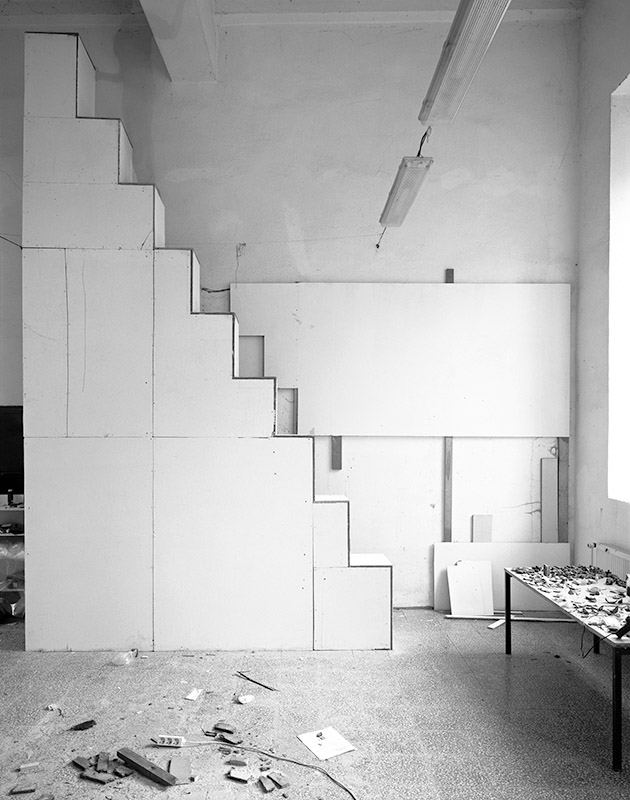FOR ENGLISH TEXT PLEASE SCROLL DOWN, THANKS.
A new perspective, 7 Silbergelatine-Prints auf Baryt, je 66 x 52 cm, 2016
„A new perspective“ ist im Krumauer Atelier entstanden. Vorangegangen sind Zugfahrten in die Umgebung, Fortbewegungen, die für den Entwicklungs-
prozess dieser Arbeit wichtig waren. Denn wie beim Reisen geht es auch hier um Perspektivenwechsel. „A perspective“ ist der Versuch Klampfers, eine andere Perspektive, einen anderen Blick auf den Raum des Ateliers und in weiterer Folge auf die eigene Arbeitsweise zu erlangen. Entstanden ist eine Treppe, die es ermöglichte, den Raum von oben zu sehen. Nach Fertigstellung wieder abgebaut (außer dem Künstler hat diese Arbeit niemand gesehen), ist die ursprüngliche Skulptur nicht mehr erhalten und wird nun nach Fotografien und Plänen im Museum im Maßstab 1:1 rekonstruiert und einer Neuinterpretation zugeführt. Denn im Fortführen der Fotografie von der ursprünglichen Skulptur zu deren Rekonstruktion – nun mit edlerem Material – wird der bildhauerische Arbeitsprozess rückblickend zum historischen Ereignis. Geblieben ist die Idee. Gebaut von der hauseigenen Werkstatt zieht sich der Künstler zurück und macht seine Skulptur in der 1:1 Übertragung aus dem viel höheren Atelier in Krumau in die niedrigeren Räume des Museums zum Anschauungsobjekt unterschiedlicher räumlicher Dimensionen, zum Erlebnis für die Betrachterin, den Betrachter. Es wird hier aber noch zum einen darin der Ewigkeitsanspruch der Skulptur im Temporären ironisch ad absurdum geführt, zum anderen das Künstleratelier als künstlerische Produktionsstätte, als ein Ort des Werdens und Verschwindens verstanden. Denn nicht jedes Werk findet in eine Ausstellung. Ausgehend von der gebauten und begehbaren Skulptur im Atelier führt Klampfer als Artist-in-Residence diese via Fotografie wieder in den realen Raum des Museums zurück. Das Museum wird zum einen zum temporären Atelier, zum anderen bleibt es nach der Ausstellungseröffnung der Repräsentations- und Wissensraum mit Erkenntnisanspruch, der ihm per definitionem zugeschrieben ist.
(Text: Günther Moschig)
– – – – – – – – – – – – – – – – – – – – – – – – – – – – – – – – – –
„A new perspective“ was created in the studio in Ceský Krumlov – following train journeys into the surroundings, changes of place, which were important for the development of his work. As with all travel, a change of perspective is involved. „A new perspective“ is Klampfer’s attempt to achieve that, a different view of the space that is the studio and subsequently of his own mode of work. The result is a staircase that made it possible to view the room from above. Having been dismantled again upon completion – and noone apart from the artist ever saw it –, the original sculpture no longer exists and has now been rebuilt to full scale from photographs and plans in the museum and made the subject of a reinterpretation. In the continuation of photography from the original sculpture to its reconstruction – this time in more elegant materials –, the sculptural process retrospectively becomes a historical event. What has remained is the idea. With the reconstruction entrusted to the museum’s workshop, the artist withdraws and transforms his sculpture – in a full-scale transfer from the much higher-ceilinged studio in Ceský Krumlov to the lower rooms of the museum – into an illustration of different spatial dimensions and an experience for the visitor. At the same time, sculpture’s claim to eternity in the temporal is ironically taken ad absurdum, and the artist’s studio as a place of artistic production is interpreted as a place of becoming and passing. After all, not every work finds its way into an exhibition. Taking the constructed and walk-on-able sculpture in the studio as his point of departure, Klampfer – as artist in residence – returns it via photography to the real space of the museum. The museum, for its part, becomes a temporary studio on the one hand but on the other hand, after the opening of the exhibition, remains the representation and knowledge space with the claim to authenticity that is ascribed to it per definitionem.
(Text: Günther Moschig)









